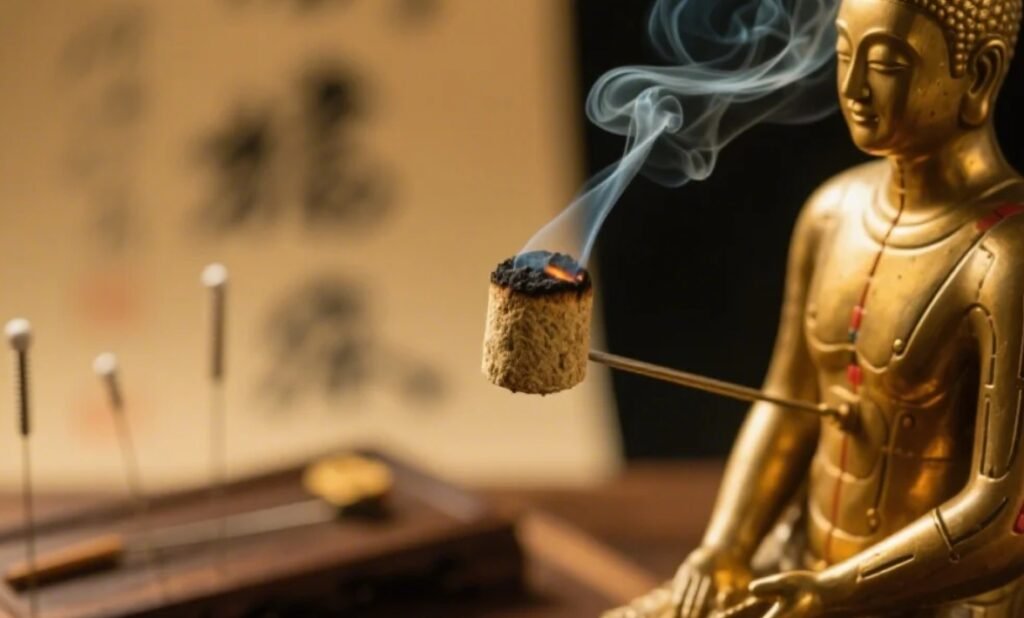Since I started purchasing mugwort leaves in 2009, and now that our moxa sticks have been on the market for over a year, I have so many emotions. It was only my passion and perseverance for moxibustion that gave me the confidence to believe it would one day be widely accepted and promoted. Despite not having a clear plan, I resolutely decided to invest, build a factory, and begin large-scale acquisition of mugwort. During that time, I had to shoulder tremendous pressure and also reassure my parents not to worry about me — that things would gradually improve. And so, I moved forward, step by step.
In the beginning, not many people in China knew about moxibustion. My original intention in building the factory was just to process moxa wool. I bought large quantities of mugwort leaves and processed them into moxa wool for wholesale export. Most moxa factories we had investigated followed this model — as long as you had moxa wool, buyers would come knocking to sign contracts. With this vision in mind, I worked hard to overcome technical challenges. By November 2010, my factory could finally produce high-quality moxa wool. Along the way, we had to repeatedly upgrade our techniques — for instance, controlling excessive dust, which made it hard to hire workers.
Eventually, we could produce moxa wool in bulk, but things didn’t go as expected. No buyers came with contracts in hand. The 2008 financial crisis had dealt a severe blow to exports. In August 2010, I opened an Alibaba Integrity store and started promoting on my own. It seemed that domestic demand was slowly warming up. However, many wholesalers wanted cheap, low-quality moxa wool, but I insisted on producing only pure moxa wool at the correct leaf-to-wool ratio, with absolutely no adulteration. I wasn’t worried about not selling — I applied for my own trademark and decided to produce finished moxa sticks myself.
So, I figured out how to make moxa sticks. But there was no one to teach me, and no machines available for purchase. I searched everywhere and finally bought a manual moxa stick rolling machine. I was thrilled. No one taught me how to use it, so I experimented on my own. On Chinese New Year’s Eve in 2010, while my family watched the Spring Festival Gala, I vowed to roll a moxa stick that night. I did, but it was uneven and ugly — even I didn’t want to use it, let alone sell it. After countless practice sessions, I was finally able to make beautiful moxa sticks. There were many nights I worked overtime, sometimes driving hundreds of kilometers with my father to ask more experienced producers for help with equipment and techniques. Eventually, I got a labor-saving machine and, by November 2010, we could finally produce saleable moxa sticks.
Slowly, customers began visiting my Alibaba store. They told me that my sincerity and detailed writing convinced them to give my product a try. I patiently answered every question. Some asked, “Why are your moxa sticks more expensive than others?” I said, “Because mine are genuine. I’m not mass-promoting yet — my yield is still small, and much of my mugwort hasn’t aged enough for processing or sale. I use my own products. I know what’s on the market too well.”
If I didn’t care about quality, I could have made a lot of money selling my mugwort at the end of 2009 when the price tripled. But I stayed true to my principles. Thanks to this honesty, many customers were willing to try. One customer from Guangxi, named Xuanxuan, really liked my moxa sticks and trusted me as a person. She even had a friend visit me to inspect the products, being very cautious. In the end, they approved the quality.
Xuanxuan ran a group full of moxibustion users and recommended my sticks to them. The ones made from the 2009 leaves — after two summers of aging — had the best cost-performance ratio. The best ones, of course, were made from leaves aged since 2007. At the time, I didn’t understand what “aged moxa” truly meant because you simply couldn’t buy it on the market. Domestic demand for moxa sticks had suddenly surged, and merchants were more interested in fast turnover than aging inventory. But I thought, if there are so many cheap “three-year-aged” sticks out there, I don’t need to compete with them. I’ll make real aged moxa sticks, so consumers can finally experience what true quality is.
Yes, mugwort shrinks in weight over time, tying up both capital and warehouse space. Real aging means higher costs. I didn’t know whether customers would accept this — I had no certainty. But I knew the market needed something genuine, and I was determined to serve that small group of quality-seeking customers. Xuanxuan’s encouragement strengthened my resolve. I suggested she open a Taobao store. My own production was limited, but I could supply her store and mine. Gradually, more people joined to help sell.
From winter 2010 to spring 2011, we experienced our first real sales peak. Winter is when people with cold or weak constitutions get sick most easily, and many look for last-minute health solutions.
Sales at the start of 2011 were good, and again in the winter. But from Dragon Boat Festival to fall of 2011, I hit my lowest point. I couldn’t sleep for two months, plagued with anxiety. From 2009 to 2010, I had kept investing. By 2011, sales picked up slightly — enough to give me confidence, to show that customers loved my products. But…
-
Storage Pressure: Sales volume was small, but I had to purchase mugwort annually. After two years of stockpiling, by the third year, I had no room left.
-
Financial Pressure: I had invested in warehouses, machinery, and raw materials for two years — income was still very limited.

Could I give up? No. I gritted my teeth and used all the money I could gather to expand the warehouse. As soon as construction finished, it was time to buy mugwort — requiring a large amount of capital. At that moment, my investors, seeing no returns for 2–3 years, declared they would no longer provide funding.
I had hoped to purchase over 100 tons of mugwort, but now I couldn’t even afford a third of that. Then buyers for moxa wool and moxa powder appeared. Faced with overwhelming financial pressure, I had no choice but to sell several tons of 5:1 moxa wool made from the current year’s leaves. Later, we sold several dozen tons of moxa powder at a low price. This helped relieve warehouse pressure and improve cash flow.
As sales gradually recovered in late 2011, I used the revenue to replenish our 2011 inventory. Finally, I could breathe a bit.
While selling moxa sticks, I also searched for user-friendly moxibustion tools. I would try everything myself before promoting it. When moxibustion became simple, more people were willing to try. The moxa waist belt I recommended in winter 2011 remained popular well into summer 2012. A customer introduced me to wooden moxibustion boxes. After testing several types, I chose a sliding-box model with adjustable side vents, made of pinewood — better than the old bamboo insert-type boxes. Tools evolved quickly because market demand forced us vendors to constantly innovate.
During all this time, I didn’t heavily promote my moxa sticks. I only had three Taobao shops carrying my products because production was still very low. The 2009 wool only made 200 boxes of sticks — with 50 packs per box. Some manufacturers would wholesale 100-box orders, each with 100 packs! Friends offered to introduce buyers or recommend wholesale markets. But I arrogantly said, “I don’t promote. I refuse to sell my goods alongside fakes.” I embarrassed some well-meaning people.
One seller liked my sticks very much, but offered such a low price that I could have fainted on the spot. I thought, forget it — no trouble. I’ll be like Jiang Taigong fishing — only those who truly appreciate it will come. Many customers couldn’t say exactly why my moxa felt better — just that it was incredibly comfortable. Yes, low-quality sticks feel harsh and irritating; they make you feel restless during (used in traditional contexts).
In 2011, I had very limited stock — just a few boxes of 2007 and 100 boxes of 2009 sticks. Some customers said the quality was great, but the price a bit high. So I produced a batch of 2010 sticks. Honestly, I didn’t like that batch — the wool was pungent, the harshness hadn’t dissipated. But due to market pressure, I released them before summer 2011. I thought aging post-production might help. But even into early 2012, the appearance and scent barely improved. The color and quality were far inferior to the 2009 sticks made after two summers of aging.
Even among the 2010 batch, those produced in the second half of the year were much better than the earlier ones. I slowly realized that while aging leaves or wool is okay, aging finished sticks requires even more time. Some customers later reported that the 2010 sticks were significantly worse. So I immediately stopped selling the ones made before summer 2011.
If a moxa stick hasn’t been aged properly, I have no right to claim it’s good. If you don’t buy it, it’s your loss.
…I started holding myself to stricter standards, taking control from the very source—ensuring that every single moxa stick was trustworthy. I realized that a truly good moxa stick isn’t just made—it’s nurtured. The species of mugwort, the timing of harvest, the degree of sun-drying, the storage environment and aging duration—none of these steps could be overlooked. I began regularly inspecting our warehouses for ventilation, moisture control, and temperature stability. I even relocated the storage facilities multiple times, all for the sake of preserving the integrity of those precious mugwort leaves.
By the second half of 2012, my confidence returned. More and more customers began to recognize the value of aged mugwort. They could tell the difference between regular moxa sticks on the market and the ones I produced. That gave me the courage to stay committed to making truly high-quality moxa, without cutting corners. Maybe my prices weren’t the lowest, but I never compromised on efficacy.
Customer feedback became my biggest motivation. One longtime client told me that after using my three-year-aged moxa sticks, her chronically cold hands and feet improved significantly—and her complexion looked healthier too. An elderly gentleman shared that other moxa sticks left him feeling overheated and irritable, but mine had a calming, soothing effect. It’s stories like these, bit by bit, that made me feel all the persistence was worthwhile.
It’s not the sellers who decide whether a moxa stick is good or not—it’s the user’s body that truly knows. Aging mugwort ties up capital and takes up warehouse space, but I believe there will always be people who understand its value. Just like when I bet everything on building that factory years ago, this is the path I’ve chosen—and I’ll walk it to the end. My goal isn’t just to run a business and make money; I want to help more people experience the healing power of moxibustion. I want this ancient traditional medicine to shine once again.
Looking ahead, I’ll keep improving our craftsmanship and exploring better tools and methods for moxibustion—making it safer, more convenient, and more effective. I won’t rush to expand or push blindly into the market. I just want to protect this small corner of the world I’ve cultivated and focus on doing one thing right: making the finest moxa sticks possible. For those who truly believe in moxibustion and need it, they deserve to no longer be misled by inferior products or waste time experimenting.
After more than a decade of persistence, I know this is only the beginning. But I believe that as long as I stay true to my mission and uphold honest production practices, more and more people will come to choose truly good moxa.


Leave a Reply